The Wearable Tremor Therapy Market is expected to register a CAGR of 6.7% from 2025 to 2031, with a market size expanding from US$ XX million in 2024 to US$ XX Million by 2031.
The report is segmented by Anatomical Location (Wrist, Hand, and Others), Product Type (Mechatronics Systems, Handheld External Devices, and Orthosis), Distribution Channel (Hospital and Retail Pharmacies, Online Stores, and Others). The global analysis is further broken-down at regional level and major countries. The Report Offers the Value in USD for the above analysis and segments.
Purpose of the Report
The report Wearable Tremor Therapy Market by The Insight Partners aims to describe the present landscape and future growth, top driving factors, challenges, and opportunities. This will provide insights to various business stakeholders, such as:
- Technology Providers/Manufacturers: To understand the evolving market dynamics and know the potential growth opportunities, enabling them to make informed strategic decisions.
- Investors: To conduct a comprehensive trend analysis regarding the market growth rate, market financial projections, and opportunities that exist across the value chain.
- Regulatory bodies: To regulate policies and police activities in the market with the aim of minimizing abuse, preserving investor trust and confidence, and upholding the integrity and stability of the market.
Wearable Tremor Therapy Market Segmentation
Anatomical Location
- Wrist
- Hand
Product Type
- Mechatronics Systems
- Handheld External Devices
- Orthosis
Distribution Channel
- Hospital and Retail Pharmacies
- Online Stores
Customize This Report To Suit Your Requirement
You will get customization on any report - free of charge - including parts of this report, or country-level analysis, Excel Data pack, as well as avail great offers and discounts for start-ups & universities
Wearable Tremor Therapy Market: Strategic Insights
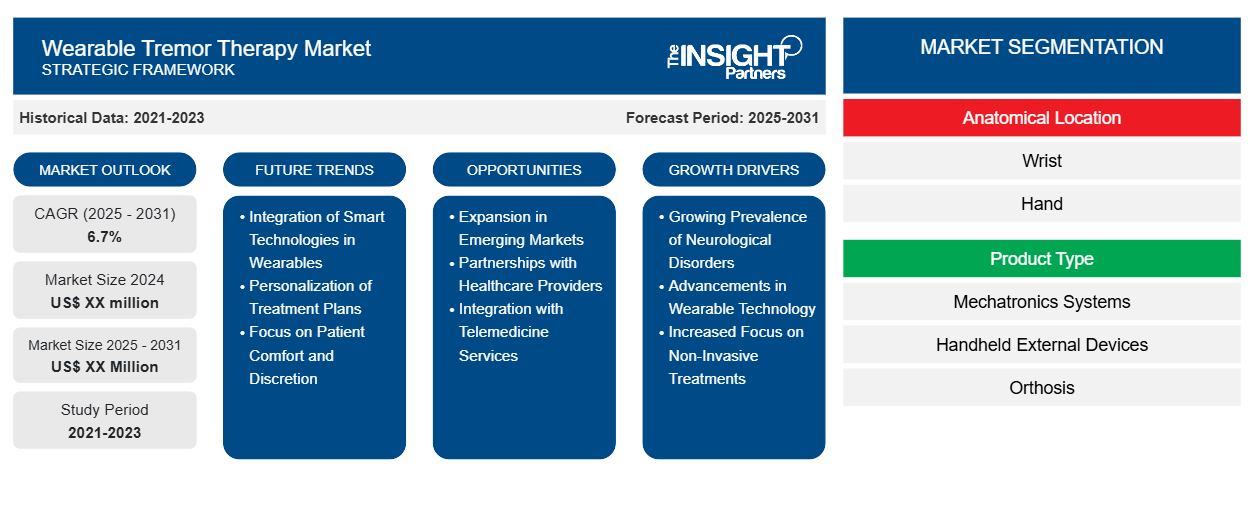
- Get Top Key Market Trends of this report.This FREE sample will include data analysis, ranging from market trends to estimates and forecasts.
Wearable Tremor Therapy Market Growth Drivers
- Growing Prevalence of Neurological Disorders: The rising incidence of neurological disorders like Parkinson's disease and essential tremor is driving demand for tremor therapy solutions. As these conditions often involve debilitating tremors, wearable therapies that offer real-time treatment solutions are becoming increasingly popular. The increasing aging population also contributes to this growing market need.
- Advancements in Wearable Technology: Technological advancements in wearable devices, such as miniaturized sensors, AI-driven algorithms, and more comfortable designs, are improving the effectiveness of tremor therapies. Wearables now provide real-time monitoring and personalized treatment, making them more attractive to patients and healthcare providers, which is expanding the market for wearable tremor therapy.
- Increased Focus on Non-Invasive Treatments: There is a shift toward non-invasive treatment options for tremor management, as patients seek alternatives to medications and surgical interventions. Wearable tremor therapies provide a non-pharmaceutical approach that can be used on-the-go, appealing to individuals who prefer convenience and fewer side effects, which boosts market demand.
Wearable Tremor Therapy Market Future Trends
- Integration of Smart Technologies in Wearables: The integration of smart technologies, such as Bluetooth connectivity, real-time feedback, and mobile applications, is becoming increasingly common in wearable tremor therapy devices. These technologies enable patients to track their symptoms, adjust settings, and communicate with healthcare providers, enhancing patient outcomes and improving adherence to treatment regimens.
- Personalization of Treatment Plans: A growing trend in wearable tremor therapy is the use of personalized treatment approaches. By leveraging AI and machine learning, wearable devices can monitor tremor severity and provide tailored therapy. This customization helps improve efficacy, as the therapy adapts to individual needs, offering more precise management of tremors for each patient.
- Focus on Patient Comfort and Discretion: Wearable tremor therapy devices are becoming more lightweight, comfortable, and discreet to wear. Patients now have options that allow them to manage their condition without drawing attention to their device. This focus on comfort and aesthetics is attracting more patients, as they can receive treatment without feeling self-conscious.
Wearable Tremor Therapy Market Opportunities
- Expansion in Emerging Markets: The wearable tremor therapy market offers significant growth potential in emerging economies where neurological diseases are on the rise, but healthcare infrastructure may be limited. As awareness of wearable therapies grows and access to these devices improves, emerging markets, particularly in Asia and Latin America, represent a key opportunity for market expansion.
- Partnerships with Healthcare Providers: Collaborating with healthcare providers and specialists, such as neurologists and rehabilitation centers, presents an opportunity for market players to offer wearable tremor therapy as part of a comprehensive treatment plan. These partnerships could increase adoption rates by integrating wearable therapy into established clinical settings and improving patient access.
- Integration with Telemedicine Services: With the rise of telemedicine and remote patient monitoring, there is an opportunity to integrate wearable tremor therapy devices with telehealth platforms. This would allow healthcare providers to monitor patients’ progress in real time, adjust therapy parameters remotely, and offer more personalized care, creating new revenue streams for device manufacturers.
Wearable Tremor Therapy Market Regional Insights
The regional trends and factors influencing the Wearable Tremor Therapy Market throughout the forecast period have been thoroughly explained by the analysts at Insight Partners. This section also discusses Wearable Tremor Therapy Market segments and geography across North America, Europe, Asia Pacific, Middle East and Africa, and South and Central America.
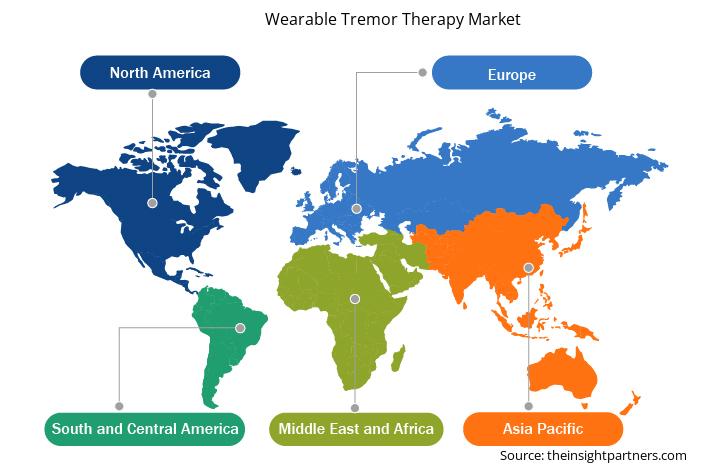
- Get the Regional Specific Data for Wearable Tremor Therapy Market
Wearable Tremor Therapy Market Report Scope
| Report Attribute | Details |
|---|---|
| Market size in 2024 | US$ XX million |
| Market Size by 2031 | US$ XX Million |
| Global CAGR (2025 - 2031) | 6.7% |
| Historical Data | 2021-2023 |
| Forecast period | 2025-2031 |
| Segments Covered |
By Anatomical Location
|
| Regions and Countries Covered | North America
|
| Market leaders and key company profiles |
Wearable Tremor Therapy Market Players Density: Understanding Its Impact on Business Dynamics
The Wearable Tremor Therapy Market market is growing rapidly, driven by increasing end-user demand due to factors such as evolving consumer preferences, technological advancements, and greater awareness of the product's benefits. As demand rises, businesses are expanding their offerings, innovating to meet consumer needs, and capitalizing on emerging trends, which further fuels market growth.
Market players density refers to the distribution of firms or companies operating within a particular market or industry. It indicates how many competitors (market players) are present in a given market space relative to its size or total market value.
Major Companies operating in the Wearable Tremor Therapy Market are:
- Harmonic Bionics
- Cala Health
- Medtronic
- IntelligentX
- AbbVie Inc.
- Tremor Technologies
Disclaimer: The companies listed above are not ranked in any particular order.
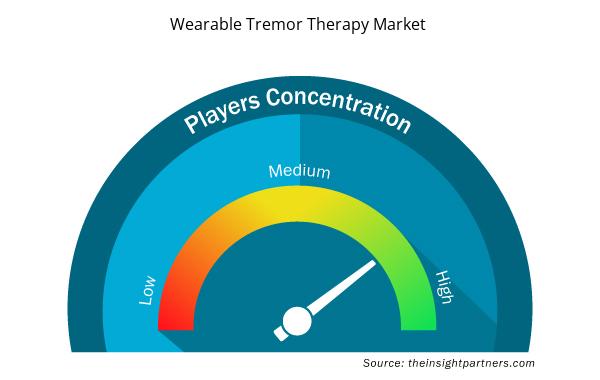
- Get the Wearable Tremor Therapy Market top key players overview
Key Selling Points
- Comprehensive Coverage: The report comprehensively covers the analysis of products, services, types, and end users of the Wearable Tremor Therapy Market, providing a holistic landscape.
- Expert Analysis: The report is compiled based on the in-depth understanding of industry experts and analysts.
- Up-to-date Information: The report assures business relevance due to its coverage of recent information and data trends.
- Customization Options: This report can be customized to cater to specific client requirements and suit the business strategies aptly.
The research report on the Wearable Tremor Therapy Market can, therefore, help spearhead the trail of decoding and understanding the industry scenario and growth prospects. Although there can be a few valid concerns, the overall benefits of this report tend to outweigh the disadvantages.
- Historical Analysis (2 Years), Base Year, Forecast (7 Years) with CAGR
- PEST and SWOT Analysis
- Market Size Value / Volume - Global, Regional, Country
- Industry and Competitive Landscape
- Excel Dataset
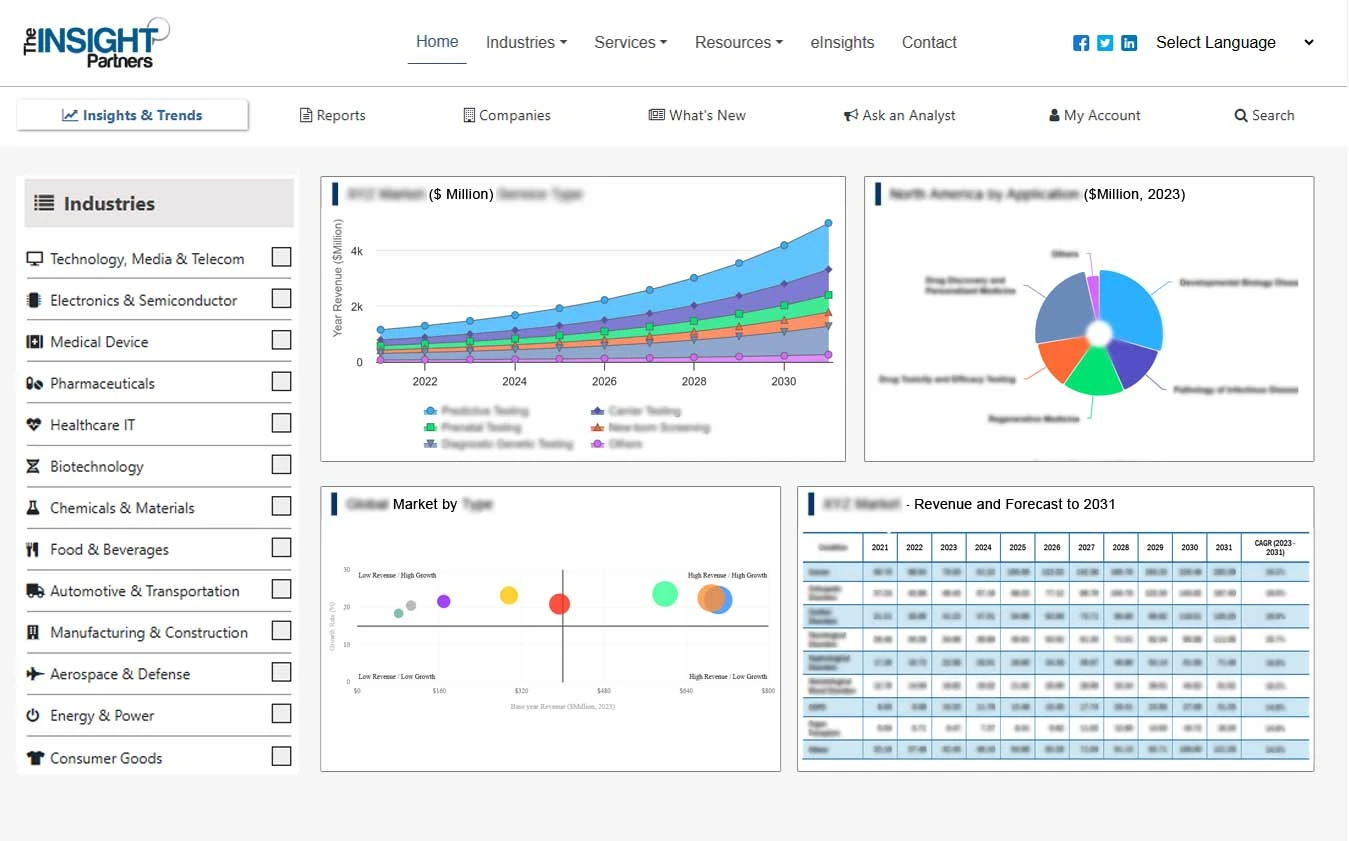

- Bathroom Vanities Market
- Medical and Research Grade Collagen Market
- Vision Guided Robotics Software Market
- Photo Editing Software Market
- Hydrogen Storage Alloys Market
- Precast Concrete Market
- Helicopters Market
- Legal Case Management Software Market
- Aircraft Wire and Cable Market
- Artificial Intelligence in Healthcare Diagnosis Market

Report Coverage
Revenue forecast, Company Analysis, Industry landscape, Growth factors, and Trends

Segment Covered
This text is related
to segments covered.

Regional Scope
North America, Europe, Asia Pacific, Middle East & Africa, South & Central America

Country Scope
This text is related
to country scope.
Frequently Asked Questions
The increasing prevalence of neurological disorders like Parkinson's disease and essential tremor, advancements in wearable technology, and the rising demand for non-invasive treatments are the main factors driving market growth.
Wearable technology enhances tremor therapy by incorporating miniaturized sensors, real-time monitoring, and AI-driven algorithms, allowing for personalized, on-the-go treatment and better patient outcomes.
Key trends include the integration of smart technologies in wearables, personalized treatment plans through AI and machine learning, and an emphasis on patient comfort and discretion in device design.
Wearable devices are becoming lighter, more comfortable, and discreet, which improves patient adherence to treatment and reduces self-consciousness, increasing market adoption.
Emerging markets present an opportunity for growth due to rising awareness of neurological diseases and limited access to healthcare. Wearable devices can fill the gap by offering affordable, non-invasive treatment solutions.
Collaborations with healthcare providers can increase adoption by integrating wearable therapy into clinical treatment plans, improving patient access and compliance, and driving the widespread use of these devices.
Trends and growth analysis reports related to Life Sciences : READ MORE..
- Harmonic Bionics
- Cala Health
- Medtronic
- IntelligentX
- AbbVie Inc.
- Tremor Technologies
- Neurolief
- Boston Scientific
- Verily Life Sciences
- TheraKey
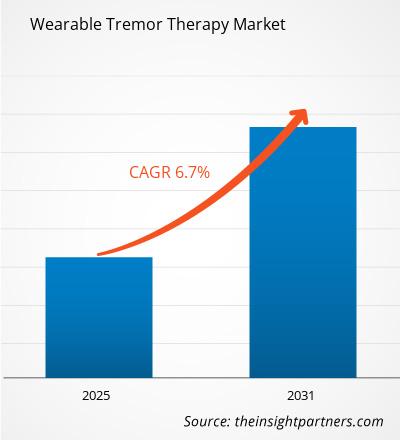
 Get Free Sample For
Get Free Sample For